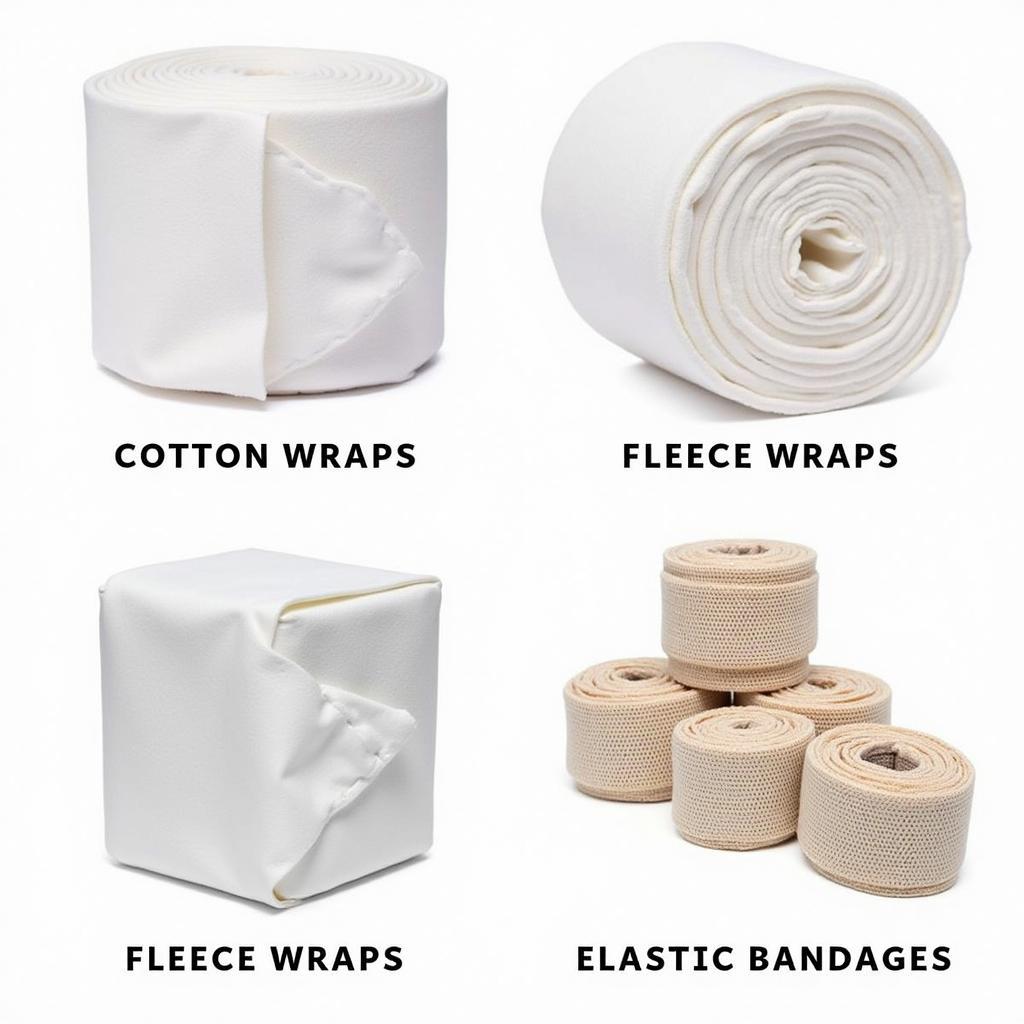Compression Wraps For Horses are a common tool used for a variety of purposes, from supporting tendons and ligaments during exercise to reducing swelling and promoting healing. Understanding how and when to use these wraps is crucial for every horse owner. This guide will delve into the benefits, application techniques, and potential risks associated with compression wraps, empowering you to make informed decisions about your horse’s leg care.
Understanding the Benefits of Compression Wraps for Horses
Compression wraps offer a range of benefits for horses, contributing to their overall leg health and well-being. They provide support to tendons and ligaments, particularly during strenuous activities like riding and jumping, helping to prevent injuries. Following strenuous exercise, compression wraps aid in reducing post-workout swelling and inflammation, promoting quicker recovery. In cases of minor injuries, these wraps can help stabilize the affected area and minimize further damage. Moreover, compression wraps can play a vital role in managing chronic conditions like arthritis, offering consistent support and reducing discomfort. They are also instrumental in protecting wounds and supporting the healing process. For example, if your horse experiences a minor cut or abrasion, a compression wrap can help keep the area clean, prevent infection, and promote faster healing. Finally, compression wraps can also be used in conjunction with horse leg ice wraps to enhance the cooling effect and reduce inflammation.
Choosing the Right Compression Wrap
Selecting the right compression wrap depends on the intended purpose and the specific needs of your horse. Different materials offer varying levels of support and breathability. Common materials include cotton, fleece, and elastic bandages. Cotton wraps are absorbent and offer good support, while fleece wraps provide additional padding and warmth. Elastic bandages are versatile and provide adjustable compression. Consider the level of support required, the duration of wear, and the horse’s individual comfort when choosing a wrap.
Types of Compression Wraps Available
 Different types of compression wraps for horses, including cotton, fleece, and elastic bandages
Different types of compression wraps for horses, including cotton, fleece, and elastic bandages
There are several types of compression wraps available, each designed for specific purposes. Standing wraps are typically used for support and protection during transport or stall rest. Exercise wraps are designed for use during riding or training, offering support and reducing the risk of injury. And as mentioned earlier, horse leg wraps for swelling are specifically designed to reduce inflammation and promote healing after injury or strenuous exercise. Remember to choose the appropriate wrap based on your horse’s individual needs. Choosing correctly can significantly impact the effectiveness of the wrap.
How to Properly Apply a Compression Wrap
Proper application is crucial for the effectiveness and safety of compression wraps. Incorrect application can lead to pressure points, discomfort, and even further injury. Start by ensuring the leg is clean and dry. Begin wrapping from just below the knee or hock, moving down towards the fetlock. Overlap each layer by approximately 50%, maintaining even tension throughout. Avoid wrapping too tightly, as this can restrict blood flow. Secure the wrap with a Velcro closure or bandage pins, ensuring it’s snug but not constricting. Remember, practice makes perfect, and consulting with a veterinarian or experienced equine professional can be beneficial for mastering the technique. They can provide valuable guidance and address any specific concerns you may have. For specific scenarios like riding, you can refer to our guide on horse leg wraps for riding for detailed instructions.
When to Consult a Veterinarian
While compression wraps can be beneficial, it’s essential to know when to seek professional advice. If your horse exhibits signs of discomfort, lameness, or increased swelling, consult a veterinarian immediately. Similarly, if the injury doesn’t improve or worsens despite using compression wraps, professional evaluation is necessary. Don’t hesitate to seek guidance if you’re unsure about the appropriate type of wrap or application technique. Your veterinarian can provide tailored advice and recommend wrap for horses legs based on your horse’s specific needs. They can also help you understand the potential risks and benefits of using compression wraps in different situations.
Conclusion
Compression wraps are a valuable tool for horse owners, offering support, promoting healing, and managing various leg conditions. However, proper application and careful monitoring are essential for ensuring their effectiveness and safety. By understanding the benefits, risks, and correct application techniques, you can effectively utilize compression wraps to maintain your horse’s leg health and overall well-being. If you’re looking for specialized boots, you might also consider equilibrium boots horse for added support and protection.
FAQ:
- How long can I leave a compression wrap on my horse?
- What are the signs of a compression wrap being too tight?
- Can I use compression wraps on a horse with a pre-existing condition?
- What’s the difference between standing wraps and exercise wraps?
- How do I clean and care for compression wraps?
- Can compression wraps be used preventatively?
- Are there any alternatives to compression wraps for leg support?
Situations where questions about compression wraps arise:
- Swelling or injury to the horse’s leg
- Before and after strenuous exercise or riding
- Transporting the horse long distances
- During stall rest to prevent stocking up
Related articles and questions:
- How to prevent leg injuries in horses?
- What are the signs of a bowed tendon?
- Understanding equine leg anatomy
Contact us for support: Phone: 0772127271, Email: [email protected], Address: QGM2+WX2, Vị Trung, Vị Thuỷ, Hậu Giang, Việt Nam. We have a 24/7 customer service team.